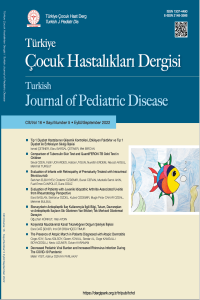Abstract
Limb Girdle Muskular distrofi (LGMD) kalça ve omuz ekleminde progresif kronik güçsüzlük ile seyreden kalıtımsal bir grup kas distrofisidir. Kalıtım paterni otozomal dominant (LGMD1) ve otozomal resesif (LGMD2) olarak ikiye ayrılır. LGMD tip 2A kalpain proteinini kodlayan gen defektine neden olan kalpainopati olarak bilinmektedir. Kas güçsüzlüğü ve başlangıç yaşına göre 3 çeşit kalpainopati tipi vardır. Bu yazıda asemptomatik persistan kreatin kinaz yüksekliği olan, kas biyopsisi ve genetik analiz ile LGMD tip 2A tanısı alan çocuk hasta sunulmaktadır. Genetik analiz sonucunda CAPN3 geninde (c.2092C>A) homozigot mutasyonu mevcut olup ebeveynlerin genetik analizinde heterozigot taşıyıcı olarak saptanmıştır.
References
- 1. Lash T, Kraemer RR. Elevated Liver Enzymes Indicating a Diagnosis of Limb-Girdle Muscular Dystrophy . J Gen Intern Med 2014 May; 29(5): 813-15.doi: 10.1007/s11606-014-2766-4. Epub 2014 Jan 23
- 2.Khadilkar SV, et al. Making sense of the clinical spectrum of limb girdle muscular dystrophies. Pract Neurol 2018;0:1–10. doi:10.1136/practneurol-2017-001799
- 3. Angelini C, Fanin M. Calpainopathy. In: Adam MP, Ardinger HH, Pagon RA, Wallace SE, Bean LJH, Stephens K, Amemiya A, editors. Gene Reviews. Seattle (WA): University of Washington,Seattle.2005:1993-2018
- 4.Angelini C, Giaretta L, Marozzo R. An update on diagnostic options and considerations in limb girdle dystrophies. Expert Rev Neurother. 2018; Sep;18(9):693-703 DOI: 10.1080/14737175.2018.1508997
- 5.Vainzof M, de Paula F, Tsanaclis AM, Zatz M. The effect of calpain 3 deficiency on the pattern of muscle degeneration in the earliest stages of LGMD2A. J Clin Pathol. 2003;56:624–6.Doi:10.1136/jcp.56.8.624
- 6.Guglieri M, Magri F, Comi G. Molecular etiopathogenesis of limb girdle muscular and congenital muscular dytrophies: Boundaries and contiguities. Clinica Chimica Acta 361 (2005) 54-79.doi:10.1016/j.cccn.2005.05.020
- 7.Guglieri M, Straub V, Bushby K, Lochmüller H. Limb-girdle muscular dystrophies. Curr Opin Neurol 2008, 21:576-584.doi: 10.1097/WCO.0b013e32830efdc2
Abstract
Limb Girdle Muscular Disease (LGMD) comprise a group of inherited muscular distrophy with chronic progressive weakness of hip and shoulder girdles. The inheritance pattern is either autosomal dominant (LGMD1) or autosomal recessive (LGMD2). LGMD 2A is known as calpainopathy in which there was a defect of gene encoding the protein named as calpain. There are three calpainopathy phenotypes according to distribution of muscle weakness and age at onset. In this report, we presented an asymptomatic child with persistant hyper CKemia diagnosed with muscle biopsy and genetic testing. Genetical examination results of the patient showed homozygote mutation of CAPN3 gene(c.2092C>A) and parents revealed that they were heterozygous unaffected carriers.
References
- 1. Lash T, Kraemer RR. Elevated Liver Enzymes Indicating a Diagnosis of Limb-Girdle Muscular Dystrophy . J Gen Intern Med 2014 May; 29(5): 813-15.doi: 10.1007/s11606-014-2766-4. Epub 2014 Jan 23
- 2.Khadilkar SV, et al. Making sense of the clinical spectrum of limb girdle muscular dystrophies. Pract Neurol 2018;0:1–10. doi:10.1136/practneurol-2017-001799
- 3. Angelini C, Fanin M. Calpainopathy. In: Adam MP, Ardinger HH, Pagon RA, Wallace SE, Bean LJH, Stephens K, Amemiya A, editors. Gene Reviews. Seattle (WA): University of Washington,Seattle.2005:1993-2018
- 4.Angelini C, Giaretta L, Marozzo R. An update on diagnostic options and considerations in limb girdle dystrophies. Expert Rev Neurother. 2018; Sep;18(9):693-703 DOI: 10.1080/14737175.2018.1508997
- 5.Vainzof M, de Paula F, Tsanaclis AM, Zatz M. The effect of calpain 3 deficiency on the pattern of muscle degeneration in the earliest stages of LGMD2A. J Clin Pathol. 2003;56:624–6.Doi:10.1136/jcp.56.8.624
- 6.Guglieri M, Magri F, Comi G. Molecular etiopathogenesis of limb girdle muscular and congenital muscular dytrophies: Boundaries and contiguities. Clinica Chimica Acta 361 (2005) 54-79.doi:10.1016/j.cccn.2005.05.020
- 7.Guglieri M, Straub V, Bushby K, Lochmüller H. Limb-girdle muscular dystrophies. Curr Opin Neurol 2008, 21:576-584.doi: 10.1097/WCO.0b013e32830efdc2
Details
| Primary Language | English |
|---|---|
| Subjects | Internal Diseases |
| Journal Section | CASE REPORTS |
| Authors | |
| Publication Date | September 20, 2022 |
| Submission Date | May 7, 2021 |
| Published in Issue | Year 2022 Volume: 16 Issue: 5 |
Cite
The publication language of Turkish Journal of Pediatric Disease is English.
Manuscripts submitted to the Turkish Journal of Pediatric Disease will go through a double-blind peer-review process. Each submission will be reviewed by at least two external, independent peer reviewers who are experts in the field, in order to ensure an unbiased evaluation process. The editorial board will invite an external and independent editor to manage the evaluation processes of manuscripts submitted by editors or by the editorial board members of the journal. The Editor in Chief is the final authority in the decision-making process for all submissions. Articles accepted for publication in the Turkish Journal of Pediatrics are put in the order of publication taking into account the acceptance dates. If the articles sent to the reviewers for evaluation are assessed as a senior for publication by the reviewers, the section editor and the editor considering all aspects (originality, high scientific quality and citation potential), it receives publication priority in addition to the articles assigned for the next issue.
The aim of the Turkish Journal of Pediatrics is to publish high-quality original research articles that will contribute to the international literature in the field of general pediatric health and diseases and its sub-branches. It also publishes editorial opinions, letters to the editor, reviews, case reports, book reviews, comments on previously published articles, meeting and conference proceedings, announcements, and biography. In addition to the field of child health and diseases, the journal also includes articles prepared in fields such as surgery, dentistry, public health, nutrition and dietetics, social services, human genetics, basic sciences, psychology, psychiatry, educational sciences, sociology and nursing, provided that they are related to this field. can be published.


